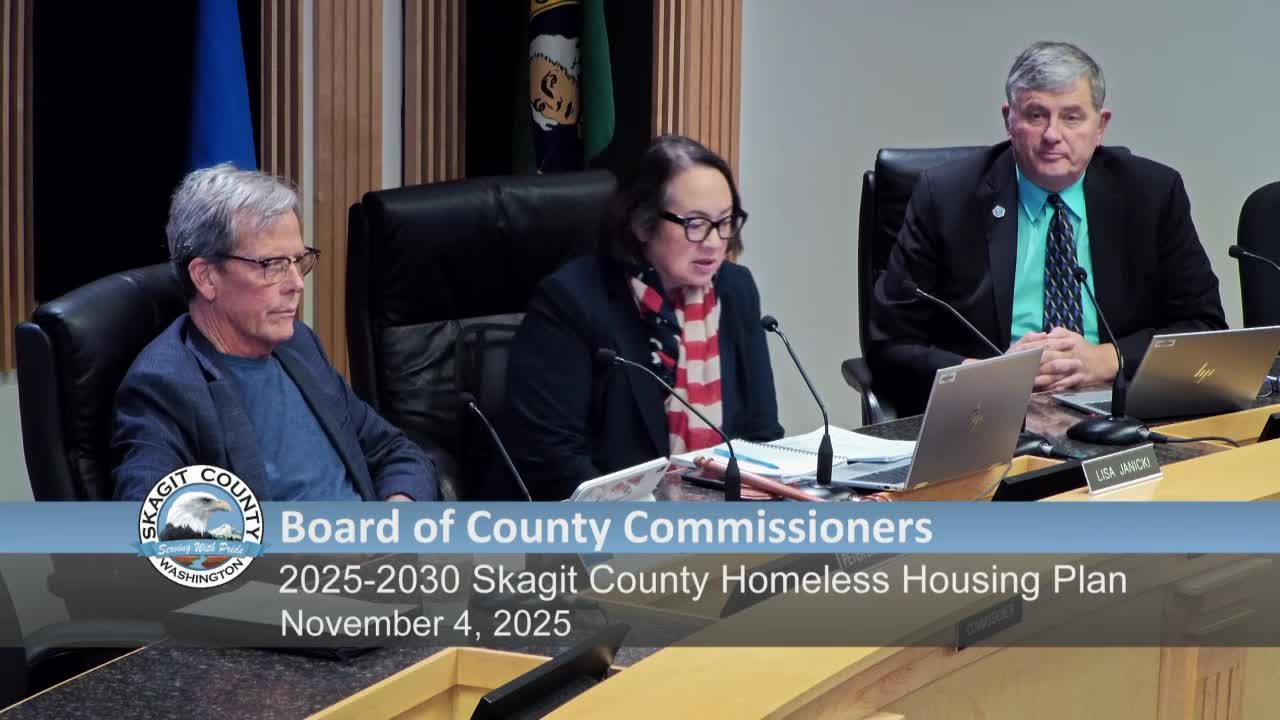Skagit County public hearing on five‑year homeless housing plan outlines six objectives, next steps
November 04, 2025 | Skagit County, Washington
This article was created by AI summarizing key points discussed. AI makes mistakes, so for full details and context, please refer to the video of the full meeting. Please report any errors so we can fix them. Report an error »

Skagit County Public Health presented its draft 2025–2030 Five‑Year Homeless Housing Plan at a Nov. 4 public hearing, outlining core objectives intended to guide funding and program decisions countywide.
Megan Starr, a housing resource coordinator, said public health and a local homeless housing task force developed the plan in 2024 with input from service providers, local governments and people with lived experience. The draft identifies families with children as a priority population and emphasizes affordable rental housing and emergency shelter among top needs.
Starr and Madeline Anthony described six objectives: promote an equitable, accountable and transparent crisis response system; strengthen the homeless service workforce; prevent episodes of homelessness; prioritize assistance for those with greatest barriers and risk of harm; house people in stable settings that meet needs; and an added county objective to eliminate unaccompanied youth and young adult homelessness.
Staff provided program‑level statistics: more than 920 households sought and qualified for services through the coordinated entry system in the past year; about 370 households remain on the housing interest pool; and roughly one in three households seeking support were able to exit to permanent housing. Anthony said the First Step Center has been able to make exceptions to the 90‑day program limit for vulnerable people and staff are working to increase flexibility where possible.
The plan aligns with regional work, including the North Star initiative and the HOME Consortium, and staff said they will finalize the plan after incorporating public comments, present it to the Board of County Commissioners in December and submit the adopted plan to the Washington State Department of Commerce. Public comment on the draft closes Nov. 5 at 4:30 p.m., staff said.
During the hearing, residents raised questions about program rules (including the First Step 90‑day limit), capacity for youth beds and volunteer support for the point‑in‑time count. Speakers from the community described volunteer efforts, host‑home pilots for youth and partnerships with organizations such as Volunteers of America to coordinate the January point‑in‑time count.
A commissioner moved and another seconded to close the public hearing; the motion carried by voice vote. Staff will return in December with a finalized plan and a record of the public comments received.
Megan Starr, a housing resource coordinator, said public health and a local homeless housing task force developed the plan in 2024 with input from service providers, local governments and people with lived experience. The draft identifies families with children as a priority population and emphasizes affordable rental housing and emergency shelter among top needs.
Starr and Madeline Anthony described six objectives: promote an equitable, accountable and transparent crisis response system; strengthen the homeless service workforce; prevent episodes of homelessness; prioritize assistance for those with greatest barriers and risk of harm; house people in stable settings that meet needs; and an added county objective to eliminate unaccompanied youth and young adult homelessness.
Staff provided program‑level statistics: more than 920 households sought and qualified for services through the coordinated entry system in the past year; about 370 households remain on the housing interest pool; and roughly one in three households seeking support were able to exit to permanent housing. Anthony said the First Step Center has been able to make exceptions to the 90‑day program limit for vulnerable people and staff are working to increase flexibility where possible.
The plan aligns with regional work, including the North Star initiative and the HOME Consortium, and staff said they will finalize the plan after incorporating public comments, present it to the Board of County Commissioners in December and submit the adopted plan to the Washington State Department of Commerce. Public comment on the draft closes Nov. 5 at 4:30 p.m., staff said.
During the hearing, residents raised questions about program rules (including the First Step 90‑day limit), capacity for youth beds and volunteer support for the point‑in‑time count. Speakers from the community described volunteer efforts, host‑home pilots for youth and partnerships with organizations such as Volunteers of America to coordinate the January point‑in‑time count.
A commissioner moved and another seconded to close the public hearing; the motion carried by voice vote. Staff will return in December with a finalized plan and a record of the public comments received.
View full meeting
This article is based on a recent meeting—watch the full video and explore the complete transcript for deeper insights into the discussion.
View full meeting
